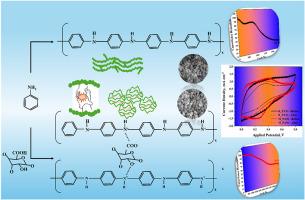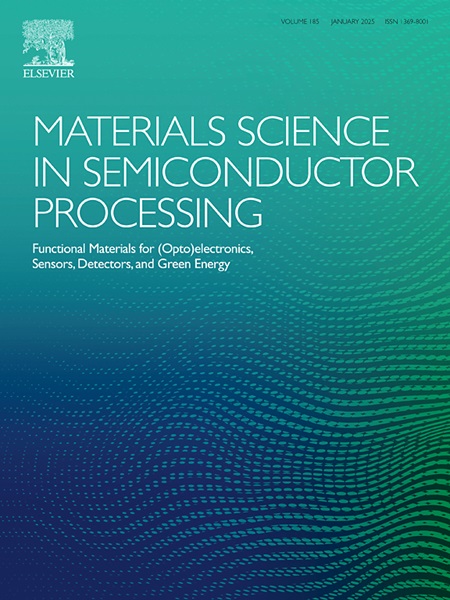生物聚合物果胶作为聚苯胺的形态改性剂:提高能量存储应用的稳定性
IF 4.2
3区 工程技术
Q2 ENGINEERING, ELECTRICAL & ELECTRONIC
引用次数: 0
摘要
生物聚合物果胶已被用作形态改性剂和掺杂剂,用于开发具有更好的特定性能和功能的聚苯胺材料。聚苯胺(PANi)因其成本低廉、易于制造、电活性、氧化还原特性和合适的电容而成为一种有趣的电化学储能电极材料,但其主要缺点是循环稳定性能较差。本研究以廉价无毒的果胶为稳定剂,通过简单的化学氧化法在 5 °C 下合成了性能增强型聚苯胺。为了进行对比研究,还合成了不含果胶的裸 PANi。通过各种技术对合成的裸 PANi(B_PANi)和果胶改性 PANi(M_PANi)进行分析,以了解果胶和 PANi 之间的化学键性质和相互作用。场发射扫描电子显微镜(FESEM)分析表明,M_PANi 的球状形态是由具有高界面接触的 PANi 纳米棒集合生成的。X 射线光电子能谱(XPS)分析证明了果胶与 PANi 纳米棒之间的界面相互作用。以 M_PANi 为电极材料、生物相容性 KCl 凝胶电解液制造的对称超级电容器装置在 3 mA cm-2 的电流密度下显示出 103.4 mF cm-2 的最大比电容。该装置在 5000 次循环中的循环稳定性为 58%,而 B_PANi 在 2500 次循环中的循环稳定性仅为 24.8%。随后还使用酸性凝胶电解液对电极的兼容性进行了检测,结果发现,5000 次循环的循环稳定性大大高于 B_PANi,达到 81%。M_PANi 成本低廉,库仑效率超过 98%,循环稳定性更好,因此对于下一代生物兼容的低成本固态储能应用来说,M_PANi 是一种极具吸引力的电极材料。本文章由计算机程序翻译,如有差异,请以英文原文为准。

Bio-polymer pectin as morphological modifier for polyaniline: Stability enhancement for energy storage applications
Bio-polymer pectin has been employed as a morphological modifier and doping agent to develop materials with improved specific properties and functions of polyaniline. Polyaniline (PANi) is an interesting electrode material for electrochemical energy storage due to its inexpensive cost, easy manufacturing, electroactivity, redox characteristics, and suitable capacitance with a major drawback of poor cyclic stability performance. Performance-enhanced polyaniline was synthesized by a simple chemical oxidative method at 5 °C using inexpensive and nontoxic pectin as a stabilizer. For a comparative study process, bare PANi was also synthesized without pectin. As-synthesized bare PANi(B_PANi) and pectin-modified PANi(M_PANi) were analysed by various techniques to understand the chemical bonding nature and interaction between pectin and PANi. Field emission scanning electron microscopy (FESEM) analysis demonstrated the spherical ball-like morphology of M_PANi generated by collective PANi nanorods with high interfacial contact. X-ray photoelectron spectroscopy (XPS) analysis proves the interfacial interaction between pectin and PANi nanorods. Symmetric supercapacitor device fabricated with M_PANi as electrode material with biocompatible KCl gel electrolyte exhibited a maximum of 103.4 mF cm−2 specific capacitance at a current density of 3 mA cm−2. The cyclic stability of the device was found to be 58 % over 5000 cycles, whereas B_PANi exhibited only 24.8 % over 2500 cycles. The electrode compatibility was also subsequently examined using an acid-based gel electrolyte, which yielded a substantially superior cyclic stability of 81 % over 5000 cycles. Because of its low cost and ability to attain over 98 % coulombic efficiency with improved cycle stability, M_PANi is an attractive electrode material for next-generation biocompatible low-cost solid-state energy storage applications.
求助全文
通过发布文献求助,成功后即可免费获取论文全文。
去求助
来源期刊

Materials Science in Semiconductor Processing
工程技术-材料科学:综合
CiteScore
8.00
自引率
4.90%
发文量
780
审稿时长
42 days
期刊介绍:
Materials Science in Semiconductor Processing provides a unique forum for the discussion of novel processing, applications and theoretical studies of functional materials and devices for (opto)electronics, sensors, detectors, biotechnology and green energy.
Each issue will aim to provide a snapshot of current insights, new achievements, breakthroughs and future trends in such diverse fields as microelectronics, energy conversion and storage, communications, biotechnology, (photo)catalysis, nano- and thin-film technology, hybrid and composite materials, chemical processing, vapor-phase deposition, device fabrication, and modelling, which are the backbone of advanced semiconductor processing and applications.
Coverage will include: advanced lithography for submicron devices; etching and related topics; ion implantation; damage evolution and related issues; plasma and thermal CVD; rapid thermal processing; advanced metallization and interconnect schemes; thin dielectric layers, oxidation; sol-gel processing; chemical bath and (electro)chemical deposition; compound semiconductor processing; new non-oxide materials and their applications; (macro)molecular and hybrid materials; molecular dynamics, ab-initio methods, Monte Carlo, etc.; new materials and processes for discrete and integrated circuits; magnetic materials and spintronics; heterostructures and quantum devices; engineering of the electrical and optical properties of semiconductors; crystal growth mechanisms; reliability, defect density, intrinsic impurities and defects.
 求助内容:
求助内容: 应助结果提醒方式:
应助结果提醒方式:


